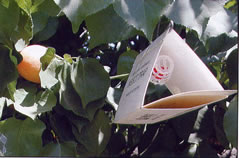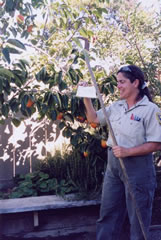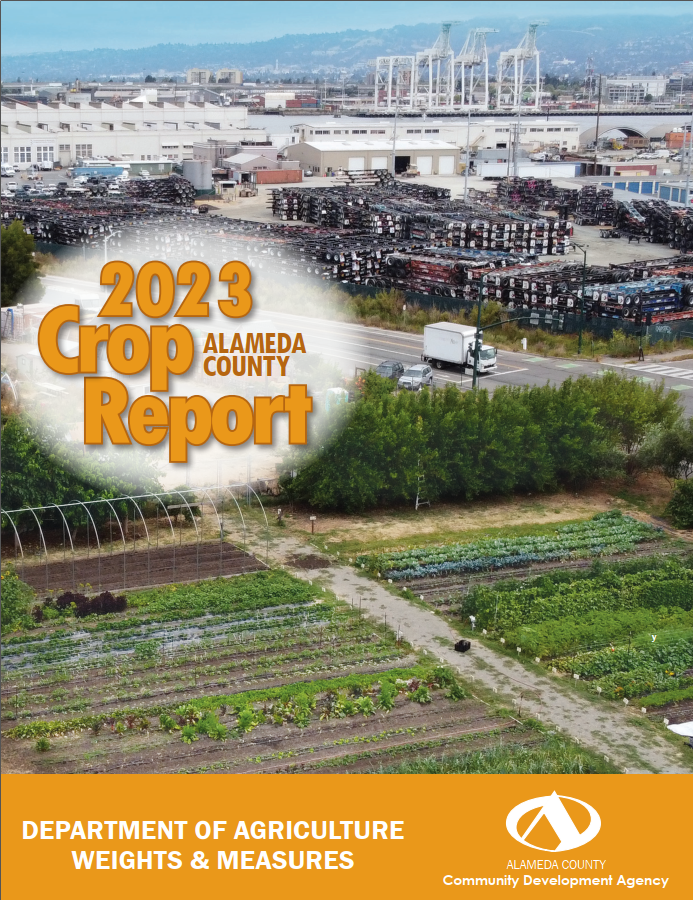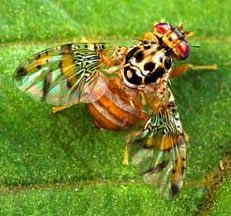Pest Detection
Mediterranean Fruit Fly

Jackson trap in an apricot tree.

County agriculture employee
inspecting a Jackson trap..
Common Name: Mediterranean Fruit Fly
Scientific Name:Ceratitis capitata Weidemann
Pest Rating: "A"
DESCRIPTION
Mediterranean fruit flies are slightly smaller than a housefly with an average length of 3.5 - 5.0 mm. Adults have a predominantly dark body with two white bands on a yellowish abdomen. Their wings have bands of brown, yellow, and black markings. They also have a distinct 'mosaic' pattern of lines and dots where the wings join the thorax (the upper body). Females have a pointed, slender ovipositor used to deposit eggs beneath the skin of the host fruit. Larvae are legless maggots creamy white in color and may grow to a length of .4 inches.
HISTORY AND ECONOMIC IMPORTANCE
Mediterranean fruit flies are one of the world's most destructive insect pests. They originated in sub-Saharan Africa. They were first discovered in the United States in the Hawaiian Islands in 1910. They attack more than 250 kinds of fruits, nuts and vegetables, many of which grow in home gardens and orchards. With an abundant supply of host fruit in which to lay its eggs, the Medfly multiplied rapidly, seriously reducing the yield and quality of many crops such as mango, guava, avocado, papaya, coffee, peach and persimmon. If this pest is established in California many key crops including apricot, avocado, grapefruit, nectarine, orange, peach, and cherry will be damaged. It has been estimated that the permanent presence of this pest in California would result in yearly losses in the hundreds of millions of dollars due to crop damages, additional pesticide use, and quarantine requirements. We will all be impacted if Medflies become established since produce prices will rise sharply. Medflies have periodically been introduced into the State since 1975. Due to a number of detection programs, eradication programs and extensive co-operation from the public, we have been able to keep them from becoming established.
You may have seen these cardboard traps in your neighborhood. Agriculture inspectors place traps like these to detect the presence of Medflies.
Male Medflies are drawn to the trap by a pheromone lure that mimics the female Medfly. Once in the trap they become stuck on a sticky insert where trappers will retrieve them.
DISTRIBUTION
Mediterranean fruit flies are widespread throughout Australia, Central and South America, Europe, and Africa. Their distribution in the United States is restricted to the Hawaiian Islands.
ALAMEDA COUNTY PEST DETECTION
Medflies were discovered in several locations in Alameda County in 1980. These finds generated an eradication program, increased trapping, and stripping all fruit from the trees in the find areas. Ground and aerial spraying were part of the eradication efforts. Eradication was declared in 1982. There have been no wild Medflies trapped in Alameda County since that time. Periodically Sterile Medflies (link to www.cdfa.ca.gov/phpps/pdep/prpinfo/pg14.html) are caught in traps that are distributed throughout Alameda County. These sterile flies are released in the southern part of California and hitchhike in autos that transport them to northern areas of the state.
Alameda County agriculture inspectors place and monitor over 1,000 insect traps for the detection of Medflies. All possible pest finds are confirmed by the State of California's Plant Pests Diagnostic Center. If a find is confirmed additional traps are deployed to determine if there is an infestation.
HOSTS AND DAMAMGE
Fruit that has been attacked may be unfit to eat. As larvae feed, they tunnel through fruit and leave it vulnerable to decay. Infested fruit will often rot and drop early. Fruit that has been attacked by a medfly usually has holes where larvae have crawled out.
Due to the seasonal nature of fruit trees, we are always looking for new host properties to place traps. If you have a fruit tree on your property and would be willing to participate in our program we would love to hear from you!
YOU CAN HELP
Working together we can keep these pests from becoming established in Alameda County. You can help by allowing Agriculture employees access to your property to install and monitor insect survey traps. To learn more, select the link below:
Pest Detection Survey

 Community Development Agency
Community Development Agency AGRICULTURE PROGRAMS
AGRICULTURE PROGRAMS

